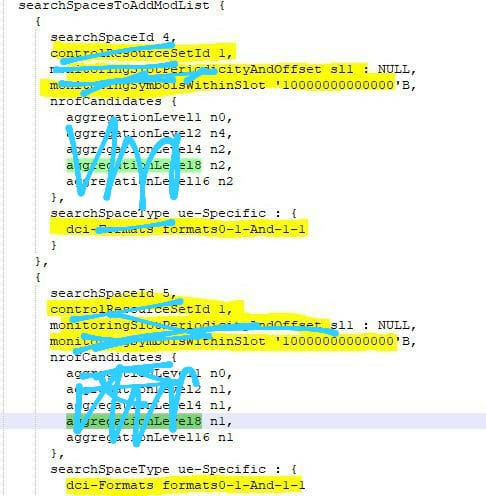Hello Experts,
Does two search space with same coreset and time domain resources impact anything from UE point of view?
Only No. Of candidates with each aggregation level is different:

Hello Experts,
Does two search space with same coreset and time domain resources impact anything from UE point of view?
Only No. Of candidates with each aggregation level is different:

In the 2nd case I see the no of blind deciding performed by UE will be less.
So it will consume less time.
Correct but UE will search both. So doesn’t matter overall time.
Now UE has to search in aggregation level 1 also?
I am thinking this is just giving network more flexibility. Not helping UE with search time.
No need to search both always. If it get his DCI, one is enough.
But if it doesn’t get it? In first search space?
No candidate with agg. Level 1
In worst case, it has to search using both the set.
Yes, aggr level 1 is not used in 5G.
True. Please remind me again what does aggregation level2…n2 actually mean?
2 candidate with agg 2.
Yes, it’s similar concept as LTE.
So ssid 5.
There is.only 1 candidate per aggregation level?
Anyway I look.at it.
I can’t see any benefit for the UE.
May be for.network there is in terms resources if ssid 5 is used.
Why? I mean it is.an.option to use.
I also think same.
Hi dears, give this some more thoughts…
Does this config even make sense for the network?
We tell the UE to look for 4 candidates in agr level2…
Then tell it to look for 1 candidate in same agr level…
Does UE now search for 5 candidates or is the second SS candidate just a subset of 1st one?
I am still finding it’s answer.
It’s clear UE will not impacted by this.
But I guess it will definitely provide some flexibility on network side.
May be in terms of CCE index allocation so that no collision with multiple UE.
Still finding answer of this.
The UE will first calculate the CCE index. Suppose the CCE index is 50, the UE will first try to decode the CCE considering the Aggregation level 1 for the 6 PDCCH candidates I e. From CCE index 50 to 55. If not succeed, it will use AGL 2 for 6 PDCCH candidates…i.e. from CCE index 50 to 61. If not succeed, it will use AGL 4 and search 2 PDCCH candidates… i.e from 50 to 57. Finally it will use AGL 8 and search 2 PDCCH candidates. I. e. From CCE index 50 to 65. So in worst case the UE has to decode a maximum of 16 blind decoding * No of DCI format supported ( that is 2 in my case, DCI format 0 and DCI format 2) i.e. the UE has to perform 32 Blind Decoding at max.
LTE. Similar concept for 5G as well.
So another slot too will have coreset I believe.
But blind decoding is 1, 2, 4, 8, 16 agg so its 5 here and if you have 2 two DCI format so it is 10 na.
So will this use same search space id.
But that too has 4 agg level.
1, 2, 4, 8 agg.
So it will decode 4 times by the way as you told.
Agl1, agl2, agl4 and agl8.
![]() for LTE
for LTE
For 5G, AGL16 is there.
But the basic concept of blind decoding is similar.
UE in poor radio conditions agg level 16.
But why UE decodes 8 CCE first as priority rather than 1 CCE? (as I read somewhere)…
I remember one of customer open case for PDCCH agg level utilization, why it’s high for agg level 8 always so consuming more CCE.